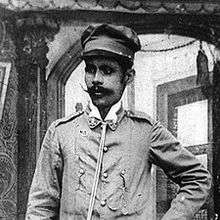Philippine Revolutionary Army
| Philippine Revolutionary Army Ejército Revolucionario Filipino Ejército en la República de la Filipina Panghimagsikang Hukbo ng Pilipinas Hukbong Pilipinong Mapaghimagsik | |
|---|---|
.svg.png) Ejercito en la República dela Filipina Emblem, 1897 | |
| Founded | March 22, 1897 |
| Country |
|
| Allegiance |
|
| Type | Army |
| Role | Military Force |
| Size | 80,000 to 100,000 (1898)[1] |
| Garrison/HQ | Kawit, Cavite |
| Nickname(s) |
"Republican Army" "Philippine Army" |
| Colors | Blue, Red, Gold and White |
| Anniversaries | March 22 |
| Engagements | Philippine RevolutionSpanish–American WarPhilippine–American War |
| Commanders | |
| President |
Su Excelencia Gen. Emilio Aguinaldo |
| Commanding General |
Gen. Artemio Ricarte (1897-1899) Gen. Antonio Luna (1899) |
| Notable commanders |
Gen. Simeon Ola Gen. Manuel Tinio Gen. Pío del Pilar Gen. Mariano Noriel Gen. Gregorio del Pilar Gen. Miguel Malvar Gen. Tomás Mascardo Col. Paco Román Maj. Manuel Quezon |
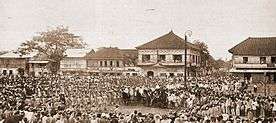
The Philippine Revolutionary Army (Filipino: Panghimagsikang Hukbo ng Pilipinas/Hukbong Pilipinong Mapaghimagsik; Spanish: Ejército Revolucionario Filipino), later renamed Philippine Republican Army (Filipino: Hukbong Katihan ng Republika ng Pilipinas; Spanish: Ejército en la República de la Filipina) was founded on March 22, 1897 in Cavite. General Artemio Ricarte was designated as its first Captain General during the Tejeros Convention.[2] This armed force of General Emilio Aguinaldo's central revolutionary government replaced the Katipunan's military force.[3]
History
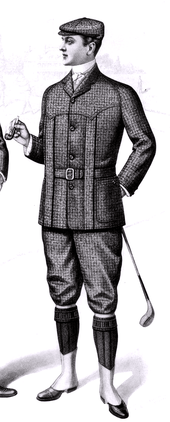

The revolutionary army used the 1896 edition of the Spanish regular army's Ordenanza del Ejército to organize its forces and establish its character as a modern army. Rules and regulations were laid down for the reorganization of the army, along with the regulation of ranks and the adoption of new fighting methods, new rank insignias, and a new standard uniform known as the rayadillo. Filipino artist Juan Luna is credited with this design.[4][5] His brother, General Antonio Luna commissioned him with the task and personally paid for the new uniforms.[6] Juan Luna also designed the collar insignia for the uniforms, distinguishing between the services: infantry, cavalry, artillery, sappers, and medics.[7] At least one researcher has postulated that Juan Luna may have patterned the tunic after the English Norfolk jacket, since the Filipino version is not a copy of any Spanish-pattern uniform.[8] Infantry officers wore blue pants with a black stripe down the side, while Cavalry officers wore red trousers with black stripes.[9][10]
Orders and circulars were issued covering matters such as building trenches and fortifications, equipping every male aged 15 to 50 with bows and arrows (as well as bolo knives, though officers wielded European swords), enticing Filipino soldiers in the Spanish army to defect, collecting empty cartridges for refilling, prohibiting unplanned sorties, inventories of captured arms and ammunition, fundraising, purchasing of arms and supplies abroad, unification of military commands, and exhorting the rich to give aid to the soldiers.[3]
Aguinaldo, a month after he declared Philippine independence, created a pay scale for officers in the army: Following the board, a brigadier general would receive 600 pesos annually, and a sergeant 72 pesos.
When the Philippine–American War erupted on February 4, 1899, the Filipino army suffered heavy losses on every sector. Even Antonio Luna urged Apolinario Mabini, Aguinaldo's chief adviser, to convince the President that guerrilla warfare must be announced as early as April 1899. Aguinaldo adopted guerilla tactics on November 13, 1899, dissolving what remained of the regular army and after many of his crack units were decimated in set-piece battles.[11]
Arsenal
The main weapon of the new Filipino army was the Spanish M93, also the standard infantry arm of the Spanish, and the Remington Spanish rifle.[3] Crew-served weapons of the Philippine military included lantakas, Krupp guns, Hontoria guns, an Ordóñez gun, Hotchkiss guns, Nordenfelt guns, Maxim guns, and Colt guns. Also, there were improvised artillery weapons made of water pipes reinforced with bamboo or timber, which can only fire once or twice.[3]
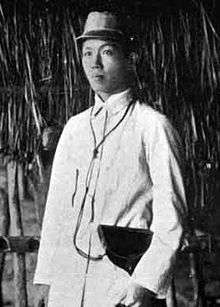

 the Murata rifle one of the first rifles used by the Filipinos during the Revolution
the Murata rifle one of the first rifles used by the Filipinos during the Revolution.jpg) the Remington Rolling Block rifle one of the first rifles used by the Filipinos during the Revolution
the Remington Rolling Block rifle one of the first rifles used by the Filipinos during the Revolution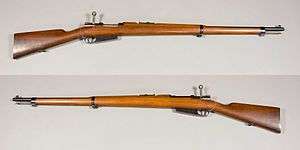 A Mauser rifle issued to the regular soldiers of the army.
A Mauser rifle issued to the regular soldiers of the army.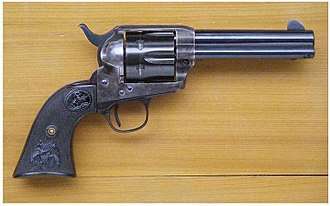 A revolver used by officers in the Philippine army.
A revolver used by officers in the Philippine army.- A Colt gun used during the Philippine Revolution.
 A Maxim gun used in some operations.
A Maxim gun used in some operations. A Nordenfelt machine gun used by the army.
A Nordenfelt machine gun used by the army.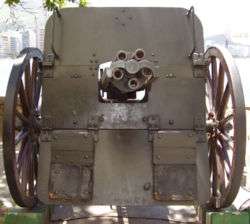 A Hotchkiss gun used by the army.
A Hotchkiss gun used by the army.- A Krupp gun used by the artillery regiments.
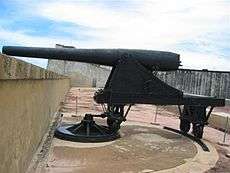 An Ordóñez gun used by the Coast Guard.
An Ordóñez gun used by the Coast Guard.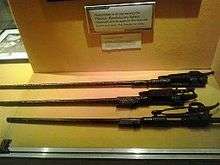 Rifles used by Filipino infantry during the Philippine Revolution and Philippine–American War on display at Clark Museum
Rifles used by Filipino infantry during the Philippine Revolution and Philippine–American War on display at Clark Museum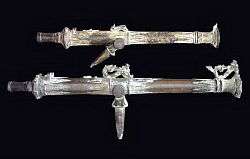 Two type of Lantaka a bronze type cannon use by the army.
Two type of Lantaka a bronze type cannon use by the army. A Bolo knife was used by a regular and high ranked soldier of the army.
A Bolo knife was used by a regular and high ranked soldier of the army.
Ranks/hierarchy
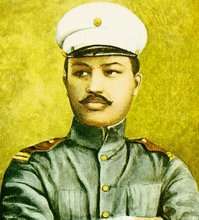

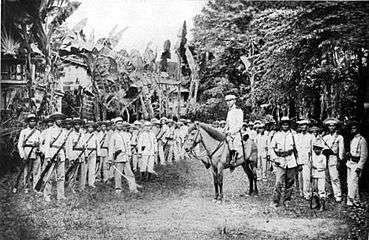
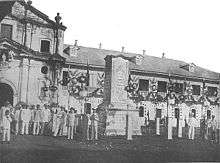
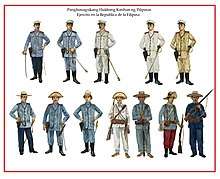
The evolution of Philippine revolutionary insignia can be divided into three basic periods; early Katipunan, late Katipunan and the Republican army.
| Revolutionary Army ranks | Tagalog Name | Spanish Name | Sleeve insignia | Shoulder epaulette insignia (1899-1901) |
|---|---|---|---|---|
| Minister Marshal | Ministrong Mariskal | Ministro Mariscal | ||
| General | Heneral | General | ||
| Lieutenant General | Tenyente Heneral | Teniente General | ||
| Major General | Heneral ng Dibisyon | General de División | ||
| Brigadier General | Heneral ng Brigada | General de Brigada | ||
| Colonel | Koronel | Coronel | ||
| Lieutenant Colonel | Tenyente Koronel | Teniente Coronel | ||
| Major | Komandante | Comandante | ||
| Captain | Kapitán | Capitán | ||
| Lieutenant | Tenyente | Teniente | ||
| Alférez
(putative) |
Alpéres
Ikalawang Tenyente |
Alférez
Segundo Teniente |
Revolutionary Army enlisted ranks
| Revolutionary Army ranks | Tagalog Name | Spanish Name | Sleeve insignia |
|---|---|---|---|
| Sergeant | Sarhento | Sargento | |
| Corporal | Kabo | Cabo |
Branch colors
In 1898, the Philippine government prescribed branch colors twice:
| Branch | 30 July 1898 | 25 November 1898 |
|---|---|---|
| Infantry | black | deep red |
| Artillery | red | green |
| Cavalry | green | black |
| Engineer Corps | violet | |
| General Staff | blue | |
| Military Juridical Corps | white | |
| Commissary and Quartermaster Corps | yellow | |
| Medical Corps | red cross |
Recruitment and conscription
During the revolution against Spain, the Katipunan gave leaflets to the people to encourage them to join the revolution. Since the revolutionaries had become regular soldiers at the time of Emilio Aguinaldo, they started to recruit males and some females aged 15 and above as a form of national service. A few Spanish and Filipino enlisted personnel and officers of the Spanish Army and Spanish Navy defected to the Revolutionary Army, as well as a number of foreign individuals and American defectors who volunteered to join during the course of the revolution.
Conscription in the revolutionary army was in effect in the Philippines and military service was mandatory at that time by the order of Gen. Antonio Luna, the Chief Commander of the Army during the Philippine–American War.[12]
Flags and early banners of the revolution
.svg.png) Official Flag of the First Philippine Republic.
Official Flag of the First Philippine Republic.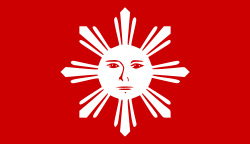 Flag of the Republic of Biak-na-Bato.
Flag of the Republic of Biak-na-Bato.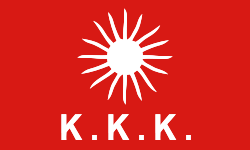 Flag used during the Cry of Pugadlawin.
Flag used during the Cry of Pugadlawin.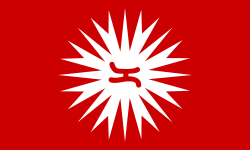 Flag of Magdiwang faction led by Mariano Álvarez
Flag of Magdiwang faction led by Mariano Álvarez () Flag of the Magdalo faction led by Baldomero Aguinaldo
() Flag of the Magdalo faction led by Baldomero Aguinaldo The KKK flag of the Katipunan was also used in many campaigns.
The KKK flag of the Katipunan was also used in many campaigns.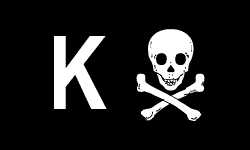 The Skull Banner by General Mariano Llanera of the republican army.
The Skull Banner by General Mariano Llanera of the republican army. Banner of Pio del Pilar, called the Bandila ng Matagumpay (Flag Of the Triumphants).
Banner of Pio del Pilar, called the Bandila ng Matagumpay (Flag Of the Triumphants).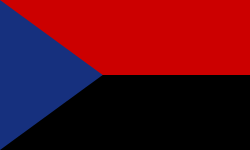 Banner of General Gregorio del Pilar, which he used during his campaigns.
Banner of General Gregorio del Pilar, which he used during his campaigns. Flag of "Republic of Katagalugan" established by Macario Sakay
Flag of "Republic of Katagalugan" established by Macario Sakay The supposed flag adopted by the Kakarong Republic was either the Katipunan banner or a plain red banner shown above.
The supposed flag adopted by the Kakarong Republic was either the Katipunan banner or a plain red banner shown above.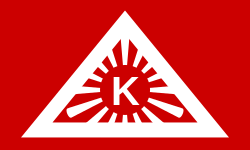 Flag of the Katipuneros of the Bicol region.
Flag of the Katipuneros of the Bicol region. Flag of the Revolutionary Government in Bacolod (1899), Republic of Negros.
Flag of the Revolutionary Government in Bacolod (1899), Republic of Negros.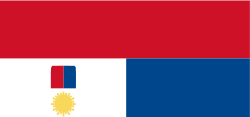 Flag of the Negros Revolution.
Flag of the Negros Revolution.
General officers
During the existence of the Revolutionary Army, over 100 individuals were appointed to General Officer grades. For details, see the List of Filipino generals in the Philippine Revolution and the Philippine–American War article.
Other notable officers
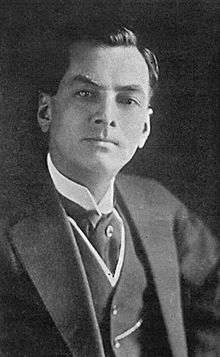
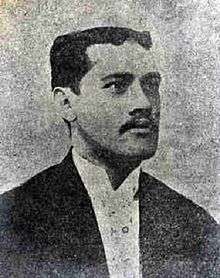
- Colonel Agapito Bonzón
- Colonel Felipe Salvador – Commander of the Santa Iglesia faction.
- Colonel Apolinar Vélez
- Colonel Alejandro Avecilla
- Colonel Francisco "Paco" Román – Aide to Lieutenant General Antonio Luna.
- Colonel Manuel Bernal – Aide to Lieutenant General Antonio Luna.
- Colonel Pablo Tecson – Leader, Battle of Quingua.
- Colonel Alipio Tecson – Supreme Military Commander of Tarlac in 1900 and exiled to Guam.
- Colonel Simón Tecson – Leader of Siege of Baler; signatory of the Biak-na-Bato Constitution.
- Colonel Simeón Villa
- Colonel Luciano San Miguel
- Colonel José Tagle – Known for his role in the Battle of Imus.
- Lieutenant Colonel Lázaro Macapagal – Commanding officer in-charge at the execution of Andrés and Procopio Bonifacio brothers.
- Lieutenant Colonel José Torres Bugallón – Hero of the Battle of La Loma.
- Lieutenant Colonel Regino Díaz Relova – Fought as one of the heads of columns under General Juan Cailles in the Laguna province.
- Captain José Bernal – Aide to Lieutenant General Antonio Luna.
- Captain Eduardo Rusca – Aide to Lieutenant General Antonio Luna.
- Captain Pedro Janolino – Commanding Officer of the Kawit Battalion.
- Captain Vicente Roa
- Captain Serapio Narváez – Officer of the 4th Company, Morong Battalion.
- Major Manuel Quezon – Aide to President Emilio Aguinaldo. Eventually succeeded him as the second President of the Philippines under the United States-sponsored Commonwealth.
- Major Juan Arce
- Lieutenant Pantaleon García – one of Gen. Luna's favorite sharpshooters of the Black Guard units.
- Corporal Anastacio Félix – 4th Company, Morong Battalion the first Filipino casualty of the Philippine–American War.[13]
Notable foreign officers and servicemen
- ARMY
- General Juan Cailles – Franco-Indian mestizo who led Filipino forces in Laguna[14]
- General José Valesy Nazaraire – Spanish.[14]
- Brigadier General José Ignacio Paua – Full-blooded Chinese general in the Army.[15]
- Brigadier General B. Natividad – Brigade Acting Commander in Vigan under General Tinio.[16]
- Colonel Manuel Sityar – Half-Spanish Director of Academía Militar de Malolos. A former captain in the Spanish colonial army who defected to the Filipino side.[17]
- Colonel Sebastian de Castro – Spanish director of the military hospital at Malasiqui, Pangasinan.[14]
- Colonel Dámaso Ybarra y Thomas – Spanish.[14]
- Lieutenant Colonel Potenciano Andrade – Spanish.[14]
- Estaquio Castellor – French mestizo who led a battalion of sharpshooters.[14]
- Major Candido Reyes – Instructor at the Academía Militar de Malolos. Former sergeant in the Spanish Army.[18]
- Major José Reyes – Instructor at the Academía Militar de Malolos. Former sergeant in the Spanish Army.[18]
- Major José Torres Bugallón – Spanish officer who served under General Luna.[14]
- Captain Antonio Costosa – Former officer in the Spanish Army.
- Captain Chizuno Iwamoto - Japanese officer who served on Emilio Aguinaldo's staff.[19] Returned to Japan after Aguinaldo's capture.[19]
- Captain David Fagen – An African-American Captain who served under Brigadier General Urbano Lacuna. A former Corporal in United States Army 24th Colored Regiment.[20][21][22]
- Captain Francisco Espina – Spanish.[16]
- Captain Estanislao de los Reyes – Spanish aide-de-camp to General Tinio.[16]
- Captain Feliciano Ramoso – Spanish aide-de-camp to General Tinio.[16]
- Captain Mariano Queri – Spanish officer who served under General Luna as an instructor in the Academía Militar de Malolos and later as the director-general of the staff of the war department.[14]
- Captain Camillo Richairdi – Italian.[14]
- Captain Telesforo Centeno – Spanish.[14]
- Captain Arthur Howard – American deserter from the 1st California Volunteers.[22]
- Captain Glen Morgan – American who organized insurgent forces in central Mindanao.[22]
- Captain John Miller – American who organized insurgent forces in central Mindanao.[22]
- Captain Russel – American deserter from the 10th Infantry.[22]
- Lieutenant Danfort – American deserter from the 10th Infantry.[22]
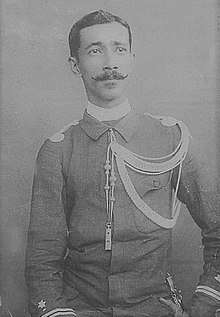 Col. Manuel Bernal Sityar
Col. Manuel Bernal Sityar - Lieutenant Maximino Lazo – Spanish.[14]
- Lieutenant Gabriel Badelly Méndez – Cuban.[14]
- 2nd Lieutenant Segundo Paz – Spanish.[14]
- Lieutenant Alejandro Quirulgico – Spanish.[16]
- Lieutenant Rafael Madina – Spanish.[16]
- Lieutenant Arsenio Romero – Spanish.[16]
- Private John Allane – United States Army.[23]
- Private Harry Dennis – United States Army.[23]
- Private William Hyer – United States Army.[24]
- Private Meeks (given name not specified) – United States Army.[23]
- Private George Raymond – 41st Infantry, United States Army.
- Private Maurice Sibley – 16th Infantry, United States Army.[25]
- Private John Wagner – United States Army.[23]
- Private Edward Walpole – United States Army.[23]
- Henry Richter – American deserter from the 9th Cavalry.[22]
- Gorth Shores – American deserter from the 9th Cavalry.[22]
- Fred Hunter – American deserter from the 9th Cavalry.[22]
- William Denten – American deserter who joined General Lukban in Samar.[22]
- Enrique Warren – American deserter who served under Francisco Makabulos in Tarlac.[22]
- Antonio Prisco – Spanish.[14]
- Manuel Alberto – Spanish.[14]
- Eugenia Plona – Spanish aide-de-camp to Baldermo Aguinaldo.[14]
- Alexander MacIntosh – English.[22]
- William McAllister – English.[22]
- Charles MacKinley – Englishman who served in Laoag.[22]
- James O'Brian – English.[22]
- NAVY
- Captain Vicente Catalán – Flag officer in-Command of the Philippine Navy. A former member of the Royal Spanish Navy.
See also
| Wikimedia Commons has media related to Philippine Revolutionary Army. |
References
- ↑ Deady 2005, p. 55 (page 3 of the PDF)
- ↑ "The Philippine Army History". Archived from the original on December 25, 2013. Retrieved 2014-01-09.
- 1 2 3 4 "Philippine-American War, 1899-1902". philippineamericanwar.webs.com. Retrieved 2012-01-28.
- ↑ Alejandrino, Jose (1949). The Price of Freedom.
- ↑ Opiña, Rimaliza (2004-11-14). "Military academy sheds West Point look". Sun.Star Baguio. Archived from the original on 2008-10-29. Retrieved 2008-05-19.
- ↑ Jose, Vivencio R. (1986). The Rise and Fall of Antonio Luna. Solar Publishing. p. 106.
- ↑ "Uniformology II". Archived from the original on 2008-05-02. Retrieved 2008-05-20.
- ↑ Combs, William K. "Filipino Rayadillo Norfolk-pattern Tunic". Retrieved 2008-05-18.
- ↑ "Filipino Rayadillo Norfolk Pattern Tunic". Retrieved 18 October 2015.
- ↑ "Uniformology I". Retrieved 2008-05-20.
- ↑ Linn 2000a, pp. 186–187
- ↑ Gregorio F. Zaide (1968). The Philippine Revolution. Modern Book Company. p. 279.
- ↑ "FIL-AM WAR BREAKS OUT". philippineamericanwar.webs.com.
- 1 2 3 4 5 6 7 8 9 10 11 12 13 14 15 16 Tan 2002, p. 249.
- ↑ Linn 2000b, p. 97.
- 1 2 3 4 5 6 7 Tan 2002, p. 108.
- ↑ Tan 2002, pp. 108, 249.
- 1 2 Halili 2004, p. 169.
- 1 2 Ambeth R. Ocampo. "Japanese with a different face". inquirer.net.
- ↑ Bowers, Hammond & MacGarrigle 1997, p. 12.
- ↑ Fantina 2006, p. 88.
- 1 2 3 4 5 6 7 8 9 10 11 12 13 14 15 Tan 2002, p. 250.
- 1 2 3 4 5 Scott 1986, pp. 36–37
- ↑ Scott 1986, pp. 36–37, 195
- ↑ Hurley, Vic (2011-06-14). Jungle Patrol, the Story of the Philippine Constabulary (1901-1936). Cerberus Books. p. 169. ISBN 978-0-9834756-2-0.
Bibliography
- Bowers, William T.; Hammond, William M.; MacGarrigle, George L. (1997). Black Soldier, White Army: The 24th Infantry Regiment in Korea. DIANE Publishing. ISBN 978-0-7881-3990-1.
- Deady, Timothy K. (Spring 2005). "Lessons from a Successful Counterinsurgency: The Philippines, 1899–1902" (PDF). Parameters. US Army War College. 35 (1): 53–68. Archived from the original (PDF) on 2009-03-26.
- Fantina, Robert (2006). Desertion and the American Soldier, 1776-2006. Algora Publishing. ISBN 978-0-87586-453-2.
- Halili, Christine N. (2004). Philippine History. Rex Bookstore, Inc. ISBN 978-971-23-3934-9.
- Linn, Brian McAllister (2000a), The Philippine War, 1899–1902, University Press of Kansas, ISBN 978-0-7006-1225-3
- Linn, Brian McAllister (2000b). The U.S. Army and Counterinsurgency in the Philippine War, 1899-1902. UNC Press Books. ISBN 978-0-8078-4948-4.
- Scott, William Henry (1986). Ilocano responses to American aggression, 1900-1901. New Day Publishers. ISBN 978-971-10-0336-4.
- Tan, Samuel K. (2002). The Filipino-American War, 1899-1913. University of the Philippines Press. ISBN 978-971-542-339-7.
In popular media
The Philippine revolutionary army has been mentioned in several Books and movies.
Films
- Tiniente Rosario - A 1937 Biopic Movie
- Dugo sa Kapirasong Lupa
- Jose Rizal Biopic movie about the National hero of the Philippines
- Ganito Kami Noon, Paano Kayo Ngayon?
- El Presidente
- Heneral Luna
- Aguila (1980)
- Baler
- Amigo (friend) - The story about the decline of the Philippine revolutionary forces
- Tirad pass:The story of Gen.Gregorio Del Pilar - 1993 Biopic film
- Bonifacio:Ang Unang Pangulo
External links
- Philippines Independence Armies: Insignia 1896 - 1902
- "Artemio Ricarte". Archived from the original on 2011-08-09. Retrieved 2012-01-28.
- Images of Filipino Republican Army rayadillo tunics
